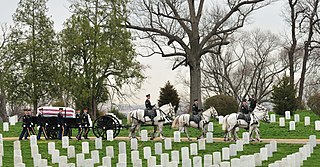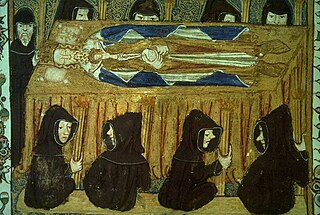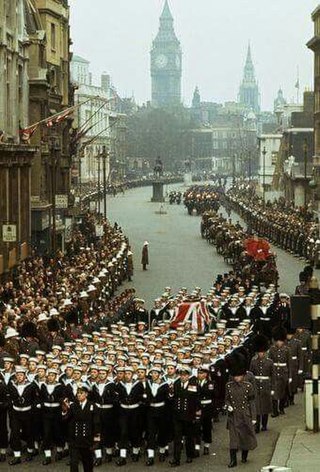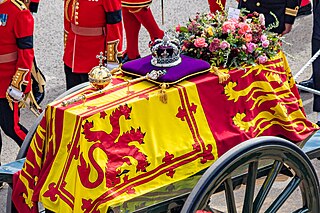
A funeral is a ceremony connected with the final disposition of a corpse, such as a burial or cremation, with the attendant observances. Funerary customs comprise the complex of beliefs and practices used by a culture to remember and respect the dead, from interment, to various monuments, prayers, and rituals undertaken in their honour. Customs vary between cultures and religious groups. Funerals have both normative and legal components. Common secular motivations for funerals include mourning the deceased, celebrating their life, and offering support and sympathy to the bereaved; additionally, funerals may have religious aspects that are intended to help the soul of the deceased reach the afterlife, resurrection or reincarnation.

Mourning is the expression of an experience that is the consequence of an event in life involving loss, causing grief, occurring as a result of someone's death, specifically someone who was loved, although loss from death is not exclusively the cause of all experience of grief.

A state visit is a formal visit by a head of state to a foreign country, at the invitation of the head of state of that foreign country, with the latter also acting as the official host for the duration of the state visit. Speaking for the host, it is generally called a state reception. State visits are considered to be the highest expression of friendly bilateral relations between two sovereign states, and are in general characterised by an emphasis on official public ceremonies.

Burial at sea is the disposal of human remains in the ocean, normally from a ship, boat or aircraft. It is regularly performed by navies, and is done by private citizens in many countries.

A military funeral is a memorial or burial rite given by a country's military for a soldier, sailor, marine or airman who died in battle, a veteran, or other prominent military figures or heads of state. A military funeral may feature guards of honor, the firing of volley shots as a salute, drumming and other military elements, with a flag draping over the coffin.

Lying in state is the tradition in which the body of a deceased official, such as a head of state, is placed in a state building, either outside or inside a coffin, to allow the public to pay their respects. It traditionally takes place in a major government building of a country, state, or city. While the practice differs among countries, in the United States, a viewing in a location other than a government building, such as a church, may be referred to as lying in repose. It is a more formal and public kind of wake or viewing. Lying in state often precedes a state funeral.

Half-mast or half-staff refers to a flag flying below the summit of a ship mast, a pole on land, or a pole on a building. In many countries this is seen as a symbol of respect, mourning, distress, or, in some cases, a salute.

A funeral train carries a coffin or coffins (caskets) to a place of interment by railway. Funeral trains today are often reserved for leaders, national heroes, or government officials, as part of a state funeral, but in the past were sometimes the chief means of transporting coffins and mourners to graveyards. Many modern era funeral trains are hauled by operationally restored steam locomotives, due to the more romantic image of the steam train against more modern diesel or electric locomotives, however non-steam powered funeral trains have been used.

State funerals in Canada are public events held to commemorate former governors general, prime ministers, other members of the cabinet who died in office, and, at the cabinet's discretion, other eminent Canadians. With ceremonial, military, and religious elements incorporated, state funerals are offered and executed by the governor general-in-council, who provides a dignified manner for the Canadian people to mourn a national public figure. Provincial and territorial governments may also perform state funerals for citizens in their particular jurisdictions. However, most state funerals are federal affairs.

In the United Kingdom, state funerals are usually reserved for monarchs. The most recent was the state funeral of Queen Elizabeth II on 19 September 2022.

King Bhumibol Adulyadej of Thailand died at the age of 88 on 13 October 2016, after a long illness. A year-long period of mourning was subsequently announced. A royal cremation ceremony took place over five days at the end of October 2017. The actual cremation, which was not broadcast on television, was held in the late evening of 26 October 2017. Following cremation his remains and ashes were taken to the Grand Palace and were enshrined at the Chakri Maha Phasat Throne Hall, the Royal Cemetery at Wat Ratchabophit and the Wat Bowonniwet Vihara Royal Temple. Following burial, the mourning period officially ended on midnight of 30 October 2017 and Thais resumed wearing colors other than black in public.
Operation London Bridge was the funeral plan for Queen Elizabeth II. The plan included the announcement of her death, the period of official mourning, and the details of her state funeral. The plan was created as early as the 1960s and revised many times in the years before her death in September 2022.

Thai funerals usually follow Buddhist funerary rites, with variations in practice depending on the culture of the region. People of certain religious and ethnic groups also have their own specific practices. Thai Buddhist funerals generally consist of a bathing ceremony shortly after death, daily chanting by Buddhist monks, and a cremation ceremony. Cremation is practised by most peoples throughout the country, with the major exceptions being ethnic Chinese, Muslims and Christians.

Thai royal funerals are elaborate events, organised as royal ceremonies akin to state funerals. They are held for deceased members of the royal family, and consist of numerous rituals which typically span several months to over a year. Featuring a mixture of Buddhist and animist beliefs, as well as Hindu symbolism, these rituals include the initial rites that take place after death, a lengthy period of lying-in-state, during which Buddhist ceremonies take place, and a final cremation ceremony. For the highest-ranking royalty, the cremation ceremonies are grand public spectacles, featuring the pageantry of large funeral processions and ornate purpose-built funeral pyres or temporary crematoria known as merumat or men. The practices date to at least the 17th century, during the time of the Ayutthaya Kingdom. Today, the cremation ceremonies are held in the royal field of Sanam Luang in the historic centre of Bangkok.
The royal cremation ceremony is the final and most major event during Thai royal funerals.

Phongyibyan is a Burmese language term for the ceremonial cremation of high-ranking Buddhist monks, in particular monks from Myanmar's largest Buddhist order, the Thudhamma Nikaya.

Sir Winston Churchill, the British statesman, soldier, and writer who served as Prime Minister of the United Kingdom during the Second World War, died on 24 January 1965, aged 90. His was the first state funeral in the United Kingdom for a non-member of the Royal Family since Edward Carson's in 1935. It was the last state funeral until Queen Elizabeth II's on 19 September 2022. The official funeral lasted for four days. Planning for the funeral, known as Operation Hope Not, began after Churchill's stroke in 1953 while in his second term as prime minister. After several revisions due to Churchill's continued survival, the plan was issued on 26 January 1965, two days after his death.

On 6 February 1952, George VI, King of the United Kingdom, died at the age of 56, at Sandringham House, after battling with a prolonged cancer. His state funeral took place on 15 February 1952. A period of national mourning commenced and his eldest daughter and successor, Queen Elizabeth II was proclaimed the new monarch by the Accession Council. George VI's coffin lay in St Mary Magdalene Church, Sandringham until 11 February when it was carried, in procession, to the nearby Wolferton railway station. The coffin was carried by train to London King's Cross railway station where another formal procession carried it to Westminster Hall where the king lay in state for three days. Some 304,000 people passed through Westminster Hall with queues up to 4 miles (6.4 km) forming.

Elizabeth II, Queen of the United Kingdom and the other Commonwealth realms, died on 8 September 2022 at Balmoral Castle in Scotland, at the age of 96. Elizabeth's reign was the longest of any British monarch. She was succeeded by her eldest son, Charles III.

















